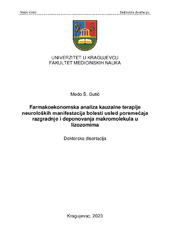Prikaz osnovnih podataka o disertaciji
Farmakoekonomska analiza kauzalne terapije neuroloških manifestacija bolesti usled poremećaja razgradnje i deponovanja makromolekula u lizozomima
Pharmacoeconomic analysis of the causal therapy of neurological manifestation of the lysosomal storage diseases
| dc.contributor.advisor | Milosavljević, Miloš | |
| dc.contributor.other | Milovanović, Dragan | |
| dc.contributor.other | Stevanović, Dejan | |
| dc.contributor.other | Stašević-Karličić, Ivana | |
| dc.creator | Gutić, Medo | |
| dc.date.accessioned | 2024-04-24T13:57:54Z | |
| dc.date.available | 2024-04-24T13:57:54Z | |
| dc.date.issued | 2023 | |
| dc.identifier.uri | http://eteze.kg.ac.rs/application/showtheses?thesesId=8724 | |
| dc.identifier.uri | https://fedorakg.kg.ac.rs/fedora/get/o:1683/bdef:Content/download | |
| dc.identifier.uri | https://nardus.mpn.gov.rs/handle/123456789/22423 | |
| dc.description.abstract | Uvod: Bolesti usled poremećaja razgradnje i deponovanja makromolekula u lizozomima (BRDL) čine heterogenu grupu rijetkih naslednih oboljenja sa oko 50 članova. Cilj ove studije je bio da uporedi troškove i efikasnost nove kauzalne terapije BRDL sa troškovima i efikasnošću suportivne ili stare kauzalne terapije. Materijal i metod: Ova studija je sprovedena pomoću izgradnje i analize farmakoekonomskih modela za tri bolesti iz grupe BRDL: Niman-Pikova bolest tip C (NP-C), kasna infantilna neuronska ceroidna lipofuscinoza tip 2 (CLN2) i Gošeova bolest tip 2 (GD2). Korišćene su dvije vrste modela: Markovljev model i model simulacije diskretnih dogaĎaja. Modeli su simulirani pomoću Monte Karlo simulacije, za kohorte od po 1,000 virtuelnih osoba. Rezultati: Liječenje pacijenata oboljelih od NP-C miglustatom kao kauzalnom terapijom nije isplativo u odnosu na liječenje ove bolesti simptomatskom terapijom. Liječenje pacijenata oboljelih od CLN2 cerliponazom alfa kao kauzalnom terapijom nije isplativo u odnosu na liječenje CLN2 simptomatskom terapijom. Kombinovana terapija ambroksola i imigluceraze se pokazala kao farmakoekonomski isplativija opcija za liječenje pacijenata oboljelih od GD2 u odnosu na monoterapiju imiglucerazom. Zaključak: Miglustat i cerliponaza alfa nisu farmakoekonomski isplative opcije za liječenje NP-C, odnosno CLN2, kada se primjene tradicionalni principi farmakoekonomske evaluacije, pa je zato neophodno da farmaceutske kompanije primjene model diferencijalnog odreĎivanja cijena koje treba da budu niže u nerazvijenim i zemljama u razvoju. Ambroksol je jeftin lijek čiju primjenu u liječenju GD2 treba podrobnije razmotriti. | sr |
| dc.description.abstract | Introduction: Lysosomal storage diseases (LSD) form a heterogeneous group of rare hereditary diseases with about 50 members. The aim of this study was to compare the costs and effectiveness of new causal therapy for LSD with the costs and effectiveness of supportive or old causal therapy. Material and methods: This study was conducted using the construction and analysis of pharmacoeconomic models for three diseases of the BRDL group: Niemann-Pick disease type C (NP-C), late infantile ceroid neuronal lipofuscinosis type 2 (CLN2), and Gaucher disease type 2 (GD2).Two types of models were used: the Markov model and the Descrete Event Simulation model. The models were simulated using Monte Carlo simulations for cohorts of 1,000 virtual individuals each. Results: Treatment of NP-C patients with miglustat as a causal therapy is not cost-effective compared to treating this disease with symptomatic therapy.Treatment of CLN2 patients with cerliponase alfa as a causal therapy is not cost-effective compared to treating CLN2 with symptomatic therapy.When compared to imiglucerase monotherapy, combined therapy with ambroxol has been found to be pharmacoeconomically more cost-effective for treating individuals with GD2. Conclusion: Miglustat and cerliponase alfa are not pharmacoeconomically cost-effective options for the treatment of NP-C, i.e., CLN2, when traditional principles of pharmacoeconomic evaluation are applied, so it is necessary for pharmaceutical companies to apply a differential pricing model that should be lower in underdeveloped and developing countries.Ambroxol is an affordable medication whose use in treatment GD2 should be given considerable thought. | en |
| dc.format | application/pdf | |
| dc.language | sr | |
| dc.publisher | Универзитет у Крагујевцу, Факултет медицинских наука | sr |
| dc.rights | openAccess | en |
| dc.rights.uri | https://creativecommons.org/licenses/by-nc-nd/4.0/ | |
| dc.source | Универзитет у Крагујевцу | sr |
| dc.subject | Bolesti usled poremećaja razgradnje i deponovanja makromolekula u lizozomima, miglustat, cerliponaza alfa, ambroksol, odnos troškova i efikasnosti. | en |
| dc.title | Farmakoekonomska analiza kauzalne terapije neuroloških manifestacija bolesti usled poremećaja razgradnje i deponovanja makromolekula u lizozomima | sr |
| dc.title.alternative | Pharmacoeconomic analysis of the causal therapy of neurological manifestation of the lysosomal storage diseases | en |
| dc.type | doctoralThesis | |
| dc.rights.license | BY-NC-ND | |
| dc.identifier.fulltext | http://nardus.mpn.gov.rs/bitstream/id/160781/Doctoral_thesis_15481.pdf | |
| dc.identifier.rcub | https://hdl.handle.net/21.15107/rcub_nardus_22423 |


